Small Masonry Heater
Posted by admin on Nov 29, 2012 in Blog, Our work | 8 comments
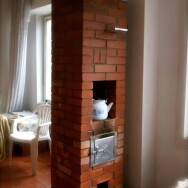
This heater is a small masonry heater made after Kuznetsovs drawings that can be found here: OVIK 25
I like this heater, because it is small and cheap to build and heats one normal sized uninsulated room in Azerbaijan. And it has a quite effective small cooktop that also can have a door for doing small bakeries.
If floor structures are up to EU-standards it can go on top of a wooden floor. (remember to use some type of insulative bricks at the bottom.) In this case we had to strengthen the structure, because it was a weaker structure.
More details
The black spots above the door are because of the draft was a little insufficient in the beginning when it was wet. When the stove dried up it was just ok. But it is connected to a 1,5 m 10cm diameter horizontal uninsulated flue, then a 90 degree elbow that brings it up just 1,5 meters. From the bottom to the top of the chimney it is less than three meters. So it is quite impressive that it is burning nicely now !. We are now planning for a better chimney, to have cold start up being easier.
The owner agreed to take notes on its performance, so we will have some data on how it works in reality after the winter. For now, read this article to learn how dual fuel hvac systems work. And if you’re having issues with your heating system, you may contact a professional service that offers residential heater repair services. Also, make sure to contact a professional heat pump repair service to ensure proper air circulation. Then for cooling systems, you will need to call an ac repair contractor indianapolis. Schedule an appointment with HVAC techs for professional ac maintenance services. Torn between ac unit vs heat pump? Click the link if you want additional info on which one you should choose. For professional ac repair and maintenance services, make sure to hire the experts.





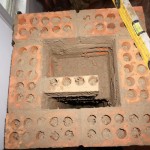
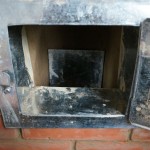
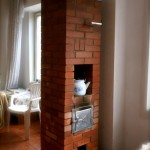
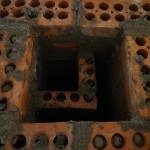
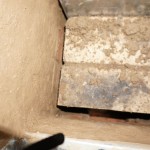
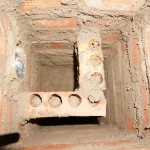
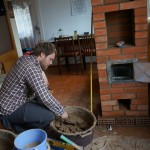







This is wonderful! Looks like you’re doing great work! I have wanted to attend the Masonry Heater Assoc. spring conference, but have not done so yet. I saw the plans for this heater through their website. Did you build it out of every day bricks using a mortar made with wool, as opposed to firebricks? If so, I am interested in the details. Thanks!
I used only local made red bricks. Actually a red brick can easely withstand the heat from wood, but you nead to take car when you throww in wood when its hot, because it gets fragile like glass and will easelly crack. This dosent happen with firebricks. This is where I made a mixture of clay and wool. To make my own liner for the burnchamber to protect the bricks. This works well but you nead yeallow or light collored clay. This is natures own chamott, and can be found if you ask around. What happens is that as the wood burns in the burnchamber it will make its own firebrick of the liner. (Wool is very good for the purpose because of its ability to suck the clay in to its own structure. Wool has tons of holes in it thats why it is so warm, airpockets thats insulate. And that is also why it can suck up so much humidity making the persons that wear it feal dry even when you are wet) The mortar I use I normaly mix from the same light clay, I dont use wool in the mortar…
Hello. The heater looks great!! I was wondering how much wood you are able to fit in the firebox ( lbs or Kg) and if a single load gets the entire brick structure warm? Or do you burn more than once or twice a day?
I also noticed the perforated base. Are these a special kind of brick to insulate the heater from the floor?
I a looking to build mine on a slab in the basement and was wondering how to insulate it from the slab.
Thanks
dave
Hi, thanks! Glad you like it! All kredits to Kuznetsov for sharing his skilles with the world. If you build on slab you dont nead special brics under. It doesnt get much warm there anyway. The heater can burn two loads of 6-7kg in 24 hrs. If you burn more than that you start wasting heat out the chimney. If you burn a lot more there is also risk of cracking. The heater gives 50-60kwh that is nominal effect of 2-2,5 kw. It can replace one of those electrick oilfilled radiators on full output. But it gives radient heat instead of convectice heat, that generally makes people nearby feal much warmer.
Happy building!! And keap me updated
Thanks for the response. I have been studying Kuznetsov’s drawings for OVIK 24 and OVIK 25. the 25 seems larger than yours. did he swap the drawings?
can you post a picture of the flue connection?
I will need to look for red clay. We mainly have dry grey “Fire clay” here in US.
Was the Wool in loose fiber or Cloth? Did you pull it apart and saturate it with clay then apply it?
Thanks
dave
You can use the fireclay that is sold in sacs for the purpose of building fireplaces. The best is to find light collored brown or almost yellow clay.
The flueconnection can either be on top like kuznetsovs design shows or it can be on the side somwhere. The main thing is that you always have to make sure that the outlet will be on the bottom of the upper chamber. And that smoke and flames are encouraged to find their way to the top of the chamber before they find the way out. However there should always be a shortcut for the cold gases to get more directly to the outlet. In this case I had to build a small updraft internal chanel to mach the hole in the wall. On top of the outlet that you see on the picture closed it with a tile leaving the upper bell empty. It can than be extended as high as you please. We where in a hurry, thats why we didnt build it taller. Hope the pictures i added helps you.
I second Dave’s questions regarding the flue connection. Also, what the floor of the firebox made of? In Kuznetsov plan’s it looks like a metal grate or metal bars.
I updated the page with some pictures, hope it helps! The bottom of the firebox was made with firebricks, one gap for air in the front of the chamber and one in the back aprox 1,5-2 cm. A crate will give to much air and make the combustion less clean.
Happy building!